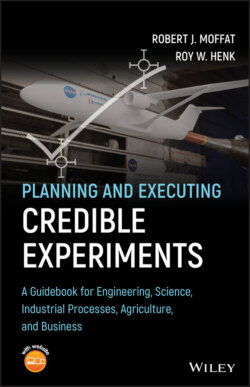Читать книгу Planning and Executing Credible Experiments - Robert J. Moffat - Страница 64
4.4 Three Levels of Questions
ОглавлениеIn terms of experiment planning, it helps to distinguish three levels of questions that might be raised during the development of an experiment plan:
Level 1: What happens?
Level 2: By what means does it happen?
Level 3: What are the underlying physics?
It is important to identify the level of the motivating question and ensure that all following decisions are aimed at progress at that same level. The different levels lead to different experiments for a given situation.
For example, consider a program aimed at studying the effects of high free‐stream turbulence u' on the value of the heat‐transfer coefficient h on a flat plate.
The Level 1 question would be: “How does the heat‐transfer coefficient h vary with free‐stream turbulence u', all other factors remaining fixed?” This question would be answered by a series of experiments in which h was measured for different values of u' for some specified set of conditions.
A Level 2 question would be: “What changes in the structure of the boundary layer were responsible for the changes in h?” This question would be answered by measurements of the velocity and temperature distribution within the boundary layer, seeking a correlation between high h and some recognizable change in the boundary layer structure.
A Level 3 question would be: “How have the momentum and energy transports within the boundary layer been altered by the turbulence?” This question would be answered by measurements of the mixing length and turbulent Prandtl number or the turbulence intensity and dissipation length scale within the boundary layer.
Note that these different levels require entirely different types of measurements, so it is important to know which level is most important to the client, the ultimate customer.
There is an implicit presumption in modern fluid mechanics and heat transfer that low‐order events can be predicted from high order, i.e. that knowledge of the turbulence transport mechanisms will allow calculation of the boundary layer structure, and that knowledge of the boundary layer structure will allow prediction of h at the surface.
This hierarchical assumption leads some experimenters to immediately start work at Level 2 or Level 3, seeking an elegant and powerful answer to the Level 1 question. In general, however, it seems to work best if one directly addresses the Level 1 question first over the entire range of the desired conditions before attempting to shift up to Level 2 and Level 3.
It is particularly important not to inadvertently mix levels in the same experiment plan. One may pursue two, or even three, levels of questions within one series of tests, and that is frequently done to save testing time, but one should remain aware that each level requires different data and that the different datasets are addressing separate objectives.
